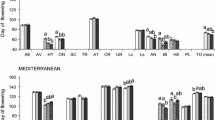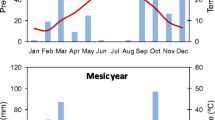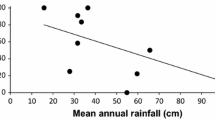Abstract
Climate change is affecting both the volume and distribution of precipitation, which in turn is expected to affect the growth and reproduction of plant populations. The near ubiquity of local adaptation suggests that adaptive differentiation may have important consequences for how populations are affected by and respond to changing precipitation. Here, we manipulated rainfall in a common garden to examine how differentiation among populations of common ragweed, Ambrosia artemisiifolia (Asteraceae) affects responses to water availability expected under climate change. We collected seeds from 26 populations along gradients of historical rainfall and used event-based rainout shelters and watering additions to simulate drier summer conditions and more extreme rainfall events, respectively. Ambrosia artemisiifolia had higher fitness on average under reduced rainfall, suggesting it may spread and become more abundant in areas projected to become hotter and drier during the summer months. We also found strong evidence for phenotypic and fitness clines across both latitude and longitude, and that phenological responses and fitness effects of altered rainfall depended on seed source or historical climate. The effect of rainfall treatment on female fitness was highest in western and mid longitudes, but there was little effect on eastern populations. Across latitude, the effect of rainfall treatment on male fitness was highest in southern populations. These phenology and fitness clines suggest that adaptive differentiation across the species’ range has the potential to shape future responses of A. artemisiifolia populations to climate change, particularly altered patterns of rainfall.





Similar content being viewed by others
References
Agren J, Schemske DW (2012) Reciprocal transplants demonstrate strong adaptive differentiation of the model organism Arabidopsis thaliana in its native range. New Phytol 194:1112–1122. https://doi.org/10.1111/j.1469-8137.2012.04112.x
Aitken SN, Whitlock MC (2012) Assisted gene flow to facilitate local adaptation to climate change. Annu Rev Ecol Evol Syst 44:131010123440000. https://doi.org/10.1146/annurev-ecolsys-110512-135747
Aitken SN, Yeaman S, Holliday JA, Wang T, Curtis-McLane S (2008) Adaptation, migration or extirpation: climate change outcomes for tree populations. Evol Appl 1:95–111. https://doi.org/10.1002/2016SW001410
Bass DJ, Delpech V, Beard J, Bass P, Walls RS (2000) Ragweed in Australia. Aerobiologia 16:107–111. https://doi.org/10.1023/A:1007696112953
Bates D, Machler M, Bolker B, Walker S (2015) Fitting linear mixed-effects models using lme4. J Stat Softw 67:1–48. https://doi.org/10.18637/jss.v067.i01
Baudis M, Ellerbrock RH, Felsmann K, Gessler A, Gimbel K, Kayler Z, Puhlmann H, Ulrich A, Weiler M, Welk E, Bruelheide H (2014) Intraspecific differences in responses to rainshelter-induced drought and competition of Fagus sylvatica L. across Germany. For Ecol Manage 330:283–293. https://doi.org/10.1016/J.FORECO.2014.07.012
Beier C, Beierkuhnlein C, Wohlgemuth T, Penuelas J, Emmett B, Körner C, de Boeck H, Christensen JH, Leuzinger S, Janssens IA, Hansen K (2012) Precipitation manipulation experiments—challenges and recommendations for the future. Ecol Lett 15:899–911. https://doi.org/10.1111/j.1461-0248.2012.01793.x
Beierkuhnlein C, Thiel D, Jentsch A, Willner E, Kreyling J (2011) Ecotypes of European grass species respond differently to warming and extreme drought. J Ecol 99:703–713. https://doi.org/10.1111/j.1365-2745.2011.01809.x
Campbell DR, Wendlandt C (2013) Altered precipitation affects plant hybrids differently than their parental species. Am J Bot 100:1322–1331. https://doi.org/10.3732/ajb.1200473
Cavender-Bares J, Ramírez-Valiente JA (2017) Physiological evidence from common garden experiments for local adaptation and adaptive plasticity to climate in American live oaks (Quercus section Virentes): implications for conservation under global change. In: Gil-Pelegrin E, Peguero-Pina J, Sancho-Knapik D (eds) Oaks physiological ecology: exploring functional diversity of the genus Quercus L. tree physiology, vol 7. Springer, Cham, pp 107–135. https://doi.org/10.1007/978-3-319-69099-5_4
Chauvel B, Dessaint F, Cardinal-Legrand C, Bretagnolle F (2006) The historical spread of Ambrosia artemisiifolia L. in France from herbarium records. J Biogeogr 33:665–673. https://doi.org/10.1111/j.1365-2699.2005.01401.x
Clausen J, Keck DD, Hiesey WM (1940) Experimental studies on the nature of species I. The effects of varied environments on western American plants. Carnegie Institute, Washington DC
Conover D, Schultz ET (1995) Phenotypic similarity and the evolutionary significance of countergradient variation. Trends Ecol Evol 10:248–252. https://doi.org/10.1016/s0169-5347(00)89081-3
Davis MB, Shaw RG (2001) Range shifts and adaptive responses to quaternary climate change. Science 292:673–679. https://doi.org/10.1126/science.292.5517.673
Didiano TJ, Johnson MTJ, Duval TP (2016) Disentangling the effects of precipitation amount and frequency on the performance of 14 grassland species. PLoS One 11:1–19. https://doi.org/10.1371/journal.pone.0162310
Dudley SA (1996) Differing selection on plant physiological traits in response to environmental water availability: a test of adaptive hypotheses. Evolution 50:92–102. https://doi.org/10.1111/j.1558-5646.1996.tb04475.x
Dunnett NP, Willis AJ, Hunt R, Grime JP (1998) A 38-year study of relations between weather and vegetation dynamics in road verges near Bibury, Gloucestershire. J Ecol 86:610–623. https://doi.org/10.1046/j.1365-2745.1998.00297.x
Eckhart VM, Geber MA, McGuire CM, Williams CF (2004) Experimental studies of adaptation in Clarkia xantina. I. Source of trait variation across a subspecies border. Evolution 58:59–70. https://doi.org/10.1554/02-450
Eisenhauer N, Cesarz S, Koller R, Worm K, Reich PB (2012) Global change belowground: impacts of elevated CO2, nitrogen, and summer drought on soil food webs and biodiversity. Glob Change Biol 18:435–447. https://doi.org/10.1111/j.1365-2486.2011.02555.x
Engelbrecht BMJ, Comita LS, Condit R, Kursar TA, Tyree MT, Turner BL, Hubbell SP (2007) Drought sensitivity shapes species distribution patterns in tropical forests. Nature 447:80–82. https://doi.org/10.1038/nature05747
Essl F, Biró K, Brandes D, Broennimann O, Bullock JM, Chapman DS, Chauvel B, Dullinger S, Fumanal B, Guisan A, Karrer G, Kazinczi G, Kueffer C, Laitung B, Lavoie C, Leitner M, Mang T, Moser D, Müller-Schärer H, Petitpierre B, Richter R, Schaffner U, Smith M, Starfinger U, Vautard R, Vogl G, von der Lippe M, Follak S (2015) Biological flora of the British Isles: Ambrosia artemisiifolia. J Ecol 103:1069–1098. https://doi.org/10.1111/1365-2745.12424
Fick SE, Hijmans RJ (2017) Worldclim 2: new 1-km spatial resolution climate surfaces for global land areas. Int J Climatol 37:4302–4315. https://doi.org/10.1002/joc.5086
Foster MM, Vitousek PM, Randolph PA (1980) The effects of ragweed (Ambrosia artemisiifolia L.) on nutrient cycling in a 1st-year old field. Am Midland Nat 10:106–113. https://doi.org/10.2307/2425044
Fox J, Weisberg S (2011) An R companion to applied regression. Sage publications inc., Thousand Oaks
Franks SJ, Sim S, Weis AE (2007) Rapid evolution of flowering time by an annual plant in response to a climate fluctuation. Proc Natl Acad Sci USA 104:1278–1282. https://doi.org/10.1073/pnas.0608379104
Frenz DA (2001) Interpreting atmospheric pollen counts for use in clinical allergy: allergic symptomology. Ann Allergy Asthma Immunol 86:150–158. https://doi.org/10.1016/S1081-1206(10)62683-X
Friedman J, Barrett SCH (2008) High outcrossing in the annual colonizing species Ambrosia artemisiifolia (Asteraceae). Ann Bot 101:1303–1309. https://doi.org/10.1093/aob/mcn039
Geyer CJ, Wagenius S, Shaw RG (2007) Aster models for life history analysis. Biometrika 94:415–426. https://doi.org/10.1093/biomet/asm030
Gorton AJ, Moeller DA, Tiffin P (2018) Little plant, big city: a test of adaptation to urban environments in common ragweed (Ambrosia artemisiifolia). Proc R Soc B Biol Sci 285:20180968. https://doi.org/10.1098/rspb.2018.0968
Hällfors MH, Liao J, Dzurisin J, Grundel R, Hyvärinen M, Towle K, Wu GC, Hellmann JJ (2016) Addressing potential local adaptation in species distribution models: implications for conservation under climate change. Ecol Appl 26:1154–1169. https://doi.org/10.1890/15-0926
Hereford J (2009) A quantitative survey of local adaptation and fitness trade-offs. Am Nat 173:579–588. https://doi.org/10.1086/597611
Hodgins KA, Rieseberg L (2011) Genetic differentiation in life-history traits of introduced and native common ragweed (Ambrosia artemisiifolia) populations. J Evol Biol 24:2731–2749. https://doi.org/10.1111/j.1420-9101.2011.02404.x
Hoffmann AA, Sgrò CM (2011) Climate change and evolutionary adaptation. Nature 470:479–485. https://doi.org/10.1038/nature09670
Holm S (1979) A simple sequentially rejective multiple test procedure. Scand J Stat 6:65–70
Hothorn T, Bretz F, Westfall P (2008) Simultaneous inference in general parametric models. Biometr J 50:346–363. https://doi.org/10.1002/bimj.200810425
IPCC (2013) Climate Change 2013: the physical science basis. In: Stocker T, Qin D, Plattner G-K, Tignor M, Allen S, Boschung A, Nauels A, Xia Y, Bex V, Midgley P (eds) Contribution of working group I to the fifth assessment report of the intergovernmental panel on climate change. Cambridge University Press, Cambridge
Jones KL (1936) Studies on Ambrosia I. The inheritance of floral types in the ragweed, Ambrosia elatior L. Am Midl Nat 17:673–699. https://doi.org/10.2307/2420093
Jump AS, Penuelas J (2005) Running to stand still: adaptation and the response of plants to rapid climate change. Ecol Lett 8:1010–1020. https://doi.org/10.1111/j.1461-0248.2005.00796.x
Kartesz JT (2015) Floristic synthesis of North America, version 1.0. Biota of North America Program (BONAP), Chapel Hill
Keller SR, Soolanayakanahally RY, Guy RD, Silim SN, Olson MS, Tiffin P (2011) Climate-driven local adaptation of ecophysiology and phenology in balsam poplar, Populus balsamifera L. (Salicaceae). Am J Bot 98:99–108. https://doi.org/10.3732/ajb.1000317
Kozlowski J (1992) Optimal allocation of resources to growth and reproduction: implications for age and size at maturity. Trends Ecol Evol 7:15–19. https://doi.org/10.1016/0169-5347(92)90192-E
Kramer PJ (1951) Causes of injury to plants resulting from flooding of the soil. Plant Physiol 26:722–736
Leiblein-Wild MC, Tackenberg O (2014) Phenotypic variation of 38 European Ambrosia artemisiifolia populations measured in a common garden experiment. Biol Invasions 16:2003–2015. https://doi.org/10.1007/s10530-014-0644-y
Leimu R, Fischer M (2008) A meta-analysis of local adaptation in plants. PLoS One 3:e4010. https://doi.org/10.1371/journal.pone.0004010
Lenth RV (2016) Least-square means: the R package lsmeans. J Stat Softw 69:1–33. https://doi.org/10.18637/jss.vo69.i01
Lewis WH, Vinay P, Zenger WE (1983) Airborne and allergenic pollen of North America. John Hopkins University Press, Baltimore
Li X-M, She D-Y, Zhang D-Y, Liao W-J (2014) Life history trait differentiation and local adaptation in invasive populations of Ambrosia artemisiifolia in China. Oecologia 177:669–677. https://doi.org/10.1007/s00442-014-3127-z
Liancourt P, Spence LA, Song DS, Lkhagva A, Sharkhuu A, Boldgiv B, Helliker BR, Petraitis PS, Casper BB (2013) Plant response to climate change varies with topography, interactions with neighbors, and ecotype. Ecology 94:444–453. https://doi.org/10.1890/12-0780.1
MacDonald AAM, Kotanen PM (2010) The effects of disturbance and enemy exclusion on performance of an invasive species, common ragweed, in its native range. Oecologia 162:977–986. https://doi.org/10.1007/s00442-009-1557-9
Martin MD, Zimmer EA, Olsen MT, Foote AD, Gilbert MTP, Brush GS (2014) Herbarium specimens reveal a historical shift in phylogeographic structure of common ragweed during native range disturbance. Mol Ecol 23:1701–1716. https://doi.org/10.1111/mec.12675
NOAA (2014) National climate assessment. NOAA, Silver Spring
Noy-Meir I (1973) Desert ecosystems: environment and producers. Annu Rev Ecol Syst 4:23–51
Peterson ML, Doak DF, Morris WF (2018) Incorporating local adaptation into forecasts of species’ distribution and abundance under climate change. Glob Change Biol. https://doi.org/10.1111/gcb.14562
Poorter L, Bongers F (2006) Leaf traits are good predictors of plant performance across 53 rain forest species. Ecology 87:1733–1743. https://doi.org/10.1890/0012-9658(2006)87%5b1733:LTAGPO%5d2.0.CO;2
R Core Team (2015) R: a language and environment for statistical computing. R Foundation for Statistical Computing, Vienna, Austria. http://www.R-project.org/. Accessed 30 Sept 2018
Ramírez-Valiente JA, Cavender-Bares J (2017) Evolutionary trade-offs between drought resistance mechanisms across a precipitation gradient in a seasonally dry tropical oak (Quercus oleoides). Tree Physiol 37:889–901. https://doi.org/10.1093/treephys/tpx040
Ramírez-Valiente JA, Deacon NJ, Etterson J, Center A, Sparks JP, Sparks KL, Longwell T, Pilz G, Cavender-Bares J (2018) Natural selection and neutral evolutionary processes contribute to genetic divergence in leaf traits across a precipitation gradient in the tropical oak Quercus oleoides. Mol Ecol 27:2176–2192. https://doi.org/10.1111/mec.14566
Rausher MD (1992) The measurement of selection on quantitative traits: biases due to environmental covariances between traits and fitness. Evolution 46:616–626. https://doi.org/10.1111/j.1558-5646.1992.tb02070.x
Reich PB, Uhl C, Walters M, Ellsworth D (1991) Leaf life-span as a determinant of leaf structure and function among 23 Amazonian tree species. Oecologia 86:16–24
Reich PB, Hobbie SE, Lee TD (2014) Plant growth enhancement by elevated CO2 eliminated by joint water and nitrogen limitation. Nat Geosci 7:920–924
Roach DA, Wulff RD (1987) Maternal effects in plants. Annu Rev Ecol Syst 18:209–235
Samis KE, Heath KD, Stinchcombe JR (2008) Discordant longitudinal clines in flowering time and phytochrome C in Arabidopsis thaliana. Evolution 62:2971–2983. https://doi.org/10.1111/j.1558-5646.2008.00484.x
Samis KE, Murren CJ, Bossdorf O, Donohue K, Fenster CB, Malmberg RL, Purugganan MD, Stinchcombe JR (2012) Longitudinal trends in climate drive flowering time clines in North American Arabidopsis thaliana. Ecol Evol 2:1162–1180. https://doi.org/10.1002/ece3.262
Schneider AC, Lee TD, Kreiser MA, Nelson GT (2014) Comparative and interactive effects of reduced precipitation frequency and volume on the growth and function of two perennial grassland species. Int J Plant Sci 175:702–712. https://doi.org/10.1086/676304
Schwinning S, Ehleringer JR (2001) Water use trade-offs and optimal adaptations to pulse-driven arid ecosystems. J Ecol 89:464–480. https://doi.org/10.1046/j.1365-2745.2001.00576.x
Sexton JP, Strauss SY, Rice KJ (2011) Gene flow increases fitness at the warm edge of a species’ range. Proc Natl Acad Sci USA 108:11704–11709. https://doi.org/10.1073/pnas.1100404108
Shaw RG, Geyer CJ, Wagenius S, Hangelbroek HH, Etterson JR (2008) Unifying life-history analyses for inference of fitness and population growth. Am Nat 172:E35–E47. https://doi.org/10.1086/588063
Siepielski AM, Morrissey MB, Buoro M, Carlson SM, Caruso CM, Clegg SM, Coulson T, Dibattista J, Gotanda KM, Francis CD, Hereford J, Kingsolver JG, Sletvold N, Svensson EI, Wade MJ, Maccoll ADC (2017) Precipitation drives global variation in natural selection. Science 962:959–962. https://doi.org/10.1126/science.aag2773
Toole EH, Brown E (1946) Final results of the Duvel buried seed experiment. J Agric Res 72:201–210
Trenberth KE, Aiguo D, Rasmussen RM, Parsons DM (2003) The changing character of precipitation. Bull Am Meteorol Soc 84:1205. https://doi.org/10.1175/BAMS-84-9-1205
Turesson G (1922) The genotypical response of the plant species to the habitat. Hereditas 3:211–350. https://doi.org/10.1111/j.1601-5223.1922.tb02734.x
Wadgymar SM, Ogilvie JE, Inouye DW, Weis AE, Anderson JT (2018) Phenological responses to multiple environmental drivers under climate change: insights from a long-term observational study and a manipulative field experiment. New Phytol 281:517–529. https://doi.org/10.1111/nph.15029
Weltzin JJF, Loik MEM, Schwinning S, Williams DG, Fay PA, Haddad BM, Harte J, Huxman TE, Knapp AK, Lin G, Pockman WT, Shaw, Small EE, Smith MD, Smith SD, Tissue DT, Zak JC (2003) Assessing the response of terrestrial ecosystems to potential changes in precipitation. BioScience 53:941. https://doi.org/10.1641/0006-3568(2003)053%5b0941:atrote%5d2.0.co;2
Willemsen RW (1975) Effect of stratification temperature and germination temperature on germination and the induction of secondary dormancy in common ragweed seeds. Am J Bot 62:1–5. https://doi.org/10.1002/j.1537-2197.1975.tb12333.x
Wu Z, Dijkstra P, Koch GW, Peñuelas J, Hungate BA (2011) Responses of terrestrial ecosystems to temperature and precipitation change: a meta-analysis of experimental manipulation. Glob Change Biol 17:927–942. https://doi.org/10.1111/j.1365-2486.2010.02302.x
Acknowledgements
We thank J.W. Benning, J.Y. Kim, A. Peschel for assistance with planting, rainout shelter deployment, and data collection in the field., M. Merello for assistance with seed collections, C.G. Willis for assistance with data analysis, R.A. Montgomery and R.G. Shaw for advice on experimental design and data analysis, R.A. Montgomery and J.S. Powers for the use of data loggers and soil moisture probes, the Living Labs Program at the University of Minnesota for providing the field site, and members of the Moeller and Tiffin labs for useful feedback and discussions. A.J.G was supported by the Natural Sciences and Engineering Research Council of Canada Postgraduate Scholarships Doctoral Program and the University of Minnesota Doctoral Dissertation Fellowship. The seed collections and field experiment were supported by the Carolyn M. Crosby Award awarded to A.J.G.
Author information
Authors and Affiliations
Contributions
AJG, PT, and DAM conceived and designed the experiment. AJG conducted all seed collections and conducted the field experiment. AJG conducted all data analyses, with advice and assistance from DAM and PT. AJG, PT, and DAM wrote the manuscript.
Corresponding author
Ethics declarations
Conflict of interest
The authors declare that they have no conflict of interest.
Additional information
Communicated by Casey P. terHorst.
Electronic supplementary material
Below is the link to the electronic supplementary material.
Rights and permissions
About this article
Cite this article
Gorton, A.J., Tiffin, P. & Moeller, D.A. Does adaptation to historical climate shape plant responses to future rainfall patterns? A rainfall manipulation experiment with common ragweed. Oecologia 190, 941–953 (2019). https://doi.org/10.1007/s00442-019-04463-4
Received:
Accepted:
Published:
Issue Date:
DOI: https://doi.org/10.1007/s00442-019-04463-4




